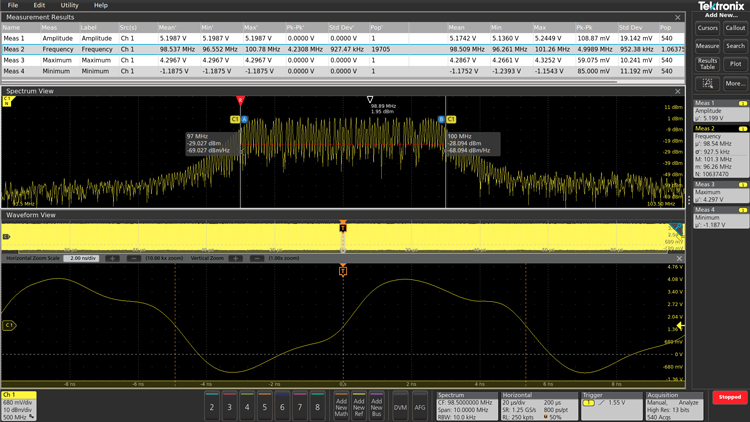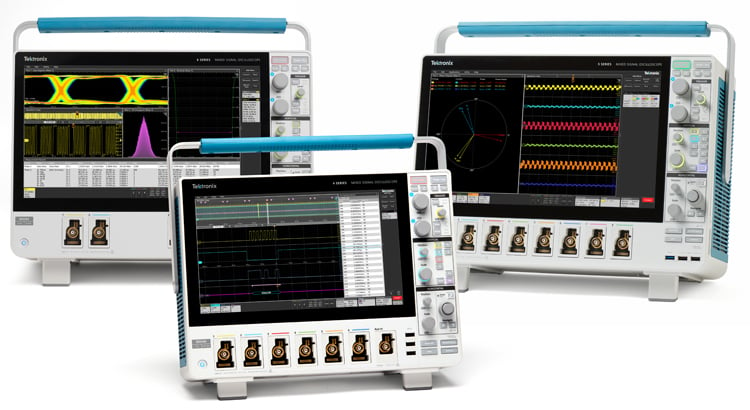4 Real-World Examples- Embedded RF Analysis

In the world of embedded RF design, engineers are facing a shift in expectations. No longer is it sufficient to capture signals from a single point of view or rely on isolated snapshots of the RF spectrum. Modern systems are increasingly complex, integrating multiple radios, antennas, and subsystems, often operating simultaneously in tightly packed environments. These complexities demand solutions that go far beyond the capabilities of traditional spectrum analyzers.
The Need for Correlation Across Channels
At the heart of these challenges is the need for correlation. RF engineers must understand not only what is happening on one channel but how signals behave across multiple channels in real time. Consider a scenario involving an embedded system with multiple RF front ends—such as in a MIMO communication device or a phased-array radar system. It becomes critically important to determine whether all channels are synchronized, how they interfere with each other, and whether their timing aligns with the expected behavior of the digital logic controlling them.
Traditional tools struggle here. A typical spectrum analyzer provides deep insight into signal characteristics like frequency content, power, and modulation—but only one signal at a time. And while time-domain tools offer complementary visibility, they often lack the resolution or correlation capability needed for true multichannel RF analysis.
Tools to Visualize Multiple RF Signals – in Real Time
To bridge this gap, Tektronix offers a suite of advanced solutions designed with these exact challenges in mind. A key innovation is the use of integrated Digital Down Converters (DDCs) on each input channel—a technology known as Spectrum View. This capability allows each channel to perform frequency-domain analysis independently and simultaneously with time-domain capture. Engineers can visualize amplitude, frequency, and phase information from multiple RF signals in real time, all while maintaining the time correlation necessary for accurate debugging and analysis.

Tektronix's 4 Series, 5 Series, and 6 Series Mixed Signal Oscilloscopes (MSOs) are at the forefront of this innovation. Each of these platforms integrates Spectrum View technology, transforming the traditional oscilloscope into a powerful multichannel spectrum analysis tool. The 4 Series MSO provides an excellent entry point for embedded RF developers, offering up to 6 input channels with synchronized analysis. The 5 Series MSO adds higher bandwidth and more advanced triggering capabilities, while the 6 Series MSO delivers best-in-class signal fidelity and bandwidth, making it ideal for cutting-edge RF applications.

Imagine being able to capture not just the RF signal from each antenna, but also the digital control lines, baseband outputs, and even environmental signals such as GPS timing or power supply variations—all at once. With Tektronix instruments using Spectrum View, each input channel can independently downconvert and analyze signals, eliminating the need to switch between modes or compromise on visibility. This holistic view of embedded RF systems is what makes modern solutions transformative.
One of the major enablers of this shift is SignalVu-PC, Tektronix’s powerful analysis software. SignalVu-PC provides an advanced suite of vector signal analysis tools, allowing engineers to perform deep RF measurements such as modulation analysis, spectral emissions testing, and time-correlated measurements across multiple domains. This software treats time not as a single waveform, but as a multidimensional framework. Engineers can freeze moments in time across channels, zoom into critical events, and measure phase differences or modulation characteristics across multiple inputs simultaneously. Instead of exporting data from different devices and struggling to align timestamps, SignalVu-PC allows for seamless, real-time correlation.
Four Examples to Illustrate Real-Time Correlation
- Take for instance a developer working on a UWB (Ultra-Wideband) communication platform. The performance of such a system often hinges on precise timing and spectral compliance. With synchronized multichannel capture and Spectrum View’s frequency-domain insight, the developer can assess the rise times, modulation envelopes, and spectral transients across all channels, ensuring compliance and detecting anomalies without guesswork.
- In another case, consider an automotive engineering team developing a next-generation ADAS (Advanced Driver-Assistance System) with radar sensors at multiple angles of the vehicle. Each sensor must not only operate independently without interference but also provide time-synchronized data for real-time fusion into a coherent environmental model. By utilizing Tektronix’s multichannel acquisition and correlation system—leveraging both Spectrum View and SignalVu—the engineers are able to validate whether chirp sequences align in time, whether intermodulation effects appear under specific driving scenarios, and how environmental reflections affect the coherence of the radar imagery. These insights help refine the radar algorithms and hardware design before vehicles hit the road.
- In the aerospace and defense sector, the need for multichannel correlation becomes even more vital. Consider the case of an electronic warfare system, where detection of hostile radar signals and response with jamming signals must be not only accurate but also precisely timed. If the system reacts too slowly or with incorrect timing, it could fail to deceive the adversary’s tracking systems. By capturing and analyzing multiple RF channels concurrently—both the threat signals and the system’s response—using SignalVu-PC, engineers can fine-tune their detection and countermeasure timing, ensuring mission-critical reliability.
- In medical technology, RF telemetry is used to transmit real-time data from implantable devices. For example, a cardiac monitor may transmit signals to an external receiver, and it’s essential to ensure these transmissions are not disrupted by environmental RF noise. Multichannel acquisition tools, enhanced by Spectrum View, allow developers to simultaneously monitor device transmissions, local RF noise, and the response from receivers, providing insights into potential interference and packet loss that would be missed with single-channel instruments.
- Moreover, in industrial IoT settings, RF-based sensors are deployed across a facility to monitor operations. These sensors must transmit reliably despite the presence of machinery-generated EMI (electromagnetic interference). With Tektronix multichannel correlation systems, engineers can capture the timing and RF emissions of the sensors along with noise sources, identifying patterns that lead to data corruption and designing mitigation strategies like frequency hopping or shielding enhancements.
Gain Confidence with a Multidimensional View
What these scenarios share is a need for high confidence in how RF signals behave not in isolation, but in context. This context is temporal, spatial, and systemic. Temporal, because timing mismatches or jitter can break a system. Spatial, because multiple antennas and nodes interact in physical space. And systemic, because RF does not operate in a vacuum—it is affected by digital logic, power integrity, and even environmental factors.
The shift in RF test and measurement is therefore about enabling engineers to move from a one-dimensional view to a multidimensional understanding. Instead of asking, “What’s happening on this one channel?” the question becomes, “How do all parts of the system behave together at this moment in time?”
This new paradigm is supported by software platforms like SignalVu-PC that allow engineers to overlay and analyze waveforms from different domains—RF, analog, digital—and to automate measurements that previously required hours of manual alignment and interpretation. They also support advanced triggering, where capture is initiated not by a simple voltage threshold, but by complex conditions like a specific bit pattern on a digital bus coinciding with a spectral spike.
The result is not just better debugging, but faster development cycles. Teams can identify and fix issues earlier in the design phase, reduce time spent in system integration, and increase confidence during validation. In a competitive marketplace where time-to-market and product reliability are crucial, these advantages are significant.
As technology continues to evolve, with trends like 6G, autonomous vehicles, and wearable medical devices, the importance of multichannel, time-correlated RF analysis will only grow. Tomorrow’s systems will be even more interconnected, with more demanding RF environments. The ability to see the full picture—not just pieces—will be essential.
Conclusion: Context, Correlation, and Clarity
In conclusion, the transformation of embedded RF design is not merely about more data or faster instruments. It’s about context, correlation, and clarity. By adopting Tektronix solutions—especially the 4, 5, and 6 Series MSOs that integrate Spectrum View and leverage the powerful capabilities of SignalVu-PC—engineers gain the tools they need to master complexity, ensure compliance, and deliver high-performance, reliable systems in an increasingly RF-dense world.


